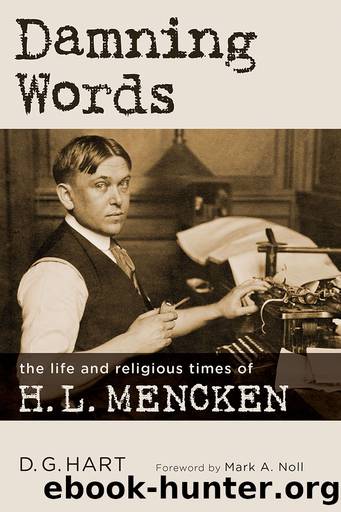Damning Words: The Life and Religious Times of H. L. Mencken by D. G. Hart

Author:D. G. Hart [Hart, D. G.]
Language: eng
Format: epub
Tags: Biography & Autobiography, Religious, Editors; Journalists; Publishers, history, United States, 20th Century
ISBN: 9781467446112
Google: sP0lDgAAQBAJ
Publisher: Wm. B. Eerdmans Publishing
Published: 2016-12-12T23:54:53.753263+00:00
CHAPTER SIX
The Mencken Show
H. L. Mencken may have taken consolation from sitting in the front row of the show produced by the United States. But during the 1920s he left his center-aisle seat and walked into the limelight. His performances took their toll and were responsible for his poor showing in Notes on Democracy. Even so, fame compensated for his failings as a political philosopher. In 1925, for instance, Walter Lippmann hailed Mencken as âthe most powerful influence on a whole generation of educated Americans.â To one editor, he was âAmericaâs Dr. Johnsonâ; to another, âthe nearest thing to Voltaire that America has ever producedâ; and to still another, âthe Genghis Khan of the Campus.â Indeed, with a circulation of sixty thousand, Menckenâs American Mercury was the item for undergraduates to be seen carrying around campus as a badge of independent thought, if not naughtiness. But his celebrity crossed over the world of language and letters into uncharted waters of popular culture. A story in New Yorkâs Daily News concluded on the basis of interviews with female readers that Mencken was the third most fascinating man in the world, tied with Rudolph Valentino, Charlie Chaplin, and Douglas Fairbanks. Fred Hobson puts it well when he says that Mencken had reversed expectations in American literary life. âPerhaps for the first time in American life a critic, rather than a novelist or a poet, was the most famous and most influential American writer.â This fame did not mean, of course, that Americans across the board considered Mencken a gift to national life. The Justice Departmentâs file on him included testimony that Mencken was a âBolshevik.â A Methodist minister called him a âmenaceâ because âhis ghastly fingers of deathâ were wrapped around the throats of Americaâs youth. Even Lippmann had to admit that Mencken was an âoutraged sentimentalist.â
The phenomenon of H. L. Mencken also meant the start of a line of books about the author. In 1925 Mencken was the subject of two assessments. The first book, a slim volume just under one hundred pages by the Irishman Ernest Boyd, evaluated Mencken as a critic and a philosopher. The second, by a former colleague at the American Mercury, Isaac Goldberg, was a biography, or as Hobson put it, a âthree-hundred-page encomiumâ that even Mencken could not resist helping in order to enhance his reputation. One reviewer of the Goldberg book announced that the âcanonization of H. L. Mencken has begun.â
In addition to compromising the first volume of his projected trilogy on lifeâs most important questions, celebrity also diminished Mencken as a reporter. Even if he enjoyed the adulation and needed to turn down numerous invitations that came with fame, Mencken could no longer attend an event without drawing attention to himself. That was especially true in two of the more famous episodes of the 1920sâ culture wars that pitted the modernists of the literary and artistic worlds, along with their liberationist cheerleaders, against the Victorians who had overseen the nationâs cultural life since the 1870s.
Download
This site does not store any files on its server. We only index and link to content provided by other sites. Please contact the content providers to delete copyright contents if any and email us, we'll remove relevant links or contents immediately.
Harry Potter and the Goblet Of Fire by J.K. Rowling(3051)
Unfinished: A Memoir by Priyanka Chopra Jonas(2918)
Never by Ken Follett(2887)
The Man Who Died Twice by Richard Osman(2301)
Machine Learning at Scale with H2O by Gregory Keys | David Whiting(2295)
Fairy Tale by Stephen King(2073)
Will by Will Smith(2045)
Rationality by Steven Pinker(1768)
The Storyteller by Dave Grohl(1662)
The Dawn of Everything: A New History of Humanity by David Graeber & David Wengrow(1571)
The Dark Hours by Michael Connelly(1571)
The Stranger in the Lifeboat by Mitch Albom(1533)
Cloud Cuckoo Land by Anthony Doerr(1440)
Friends, Lovers, and the Big Terrible Thing by Matthew Perry(1335)
New Morning Mercies: A Daily Gospel Devotional by Paul David Tripp(1334)
The Becoming by Nora Roberts(1332)
Crying in H Mart by Michelle Zauner(1316)
Einstein: His Life and Universe by Walter Isaacson(1315)
A Short History of War by Jeremy Black(1300)
